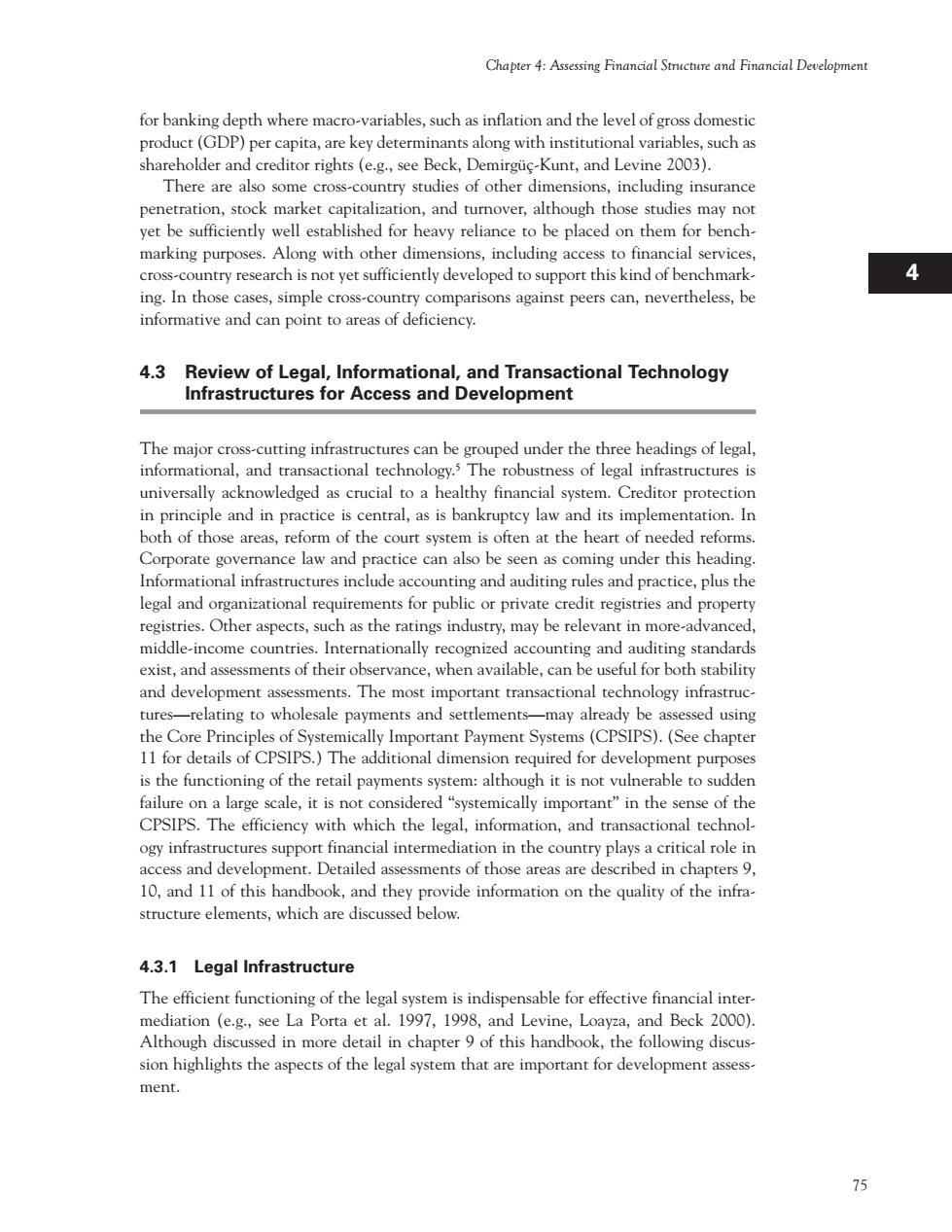正在加载图片...

Chapter 4:Assessing Financial and Financial Development for banking depth where macrovariables,such as inflation and the level of gross domestic product(GDP)per capita,are key determinants along with institutional variables,such as shareholder and creditor rights (e.g.,see Beck,Demirguc-Kunt,and Levine 2003). There are also some cross-country studies of other dimensions.including insurance penetration,stock market capitalization,and turnover,although those studies may not yet be sufficiently well established for heavy reliance to be placed on them for bench marking purpos es.Along with other dimensions,including ess to fina cial se not yet sufficieny developed o t this ki 4 ing.In those cases,simple cross-cou comparisons against peers can,nevertheless,be informative and can point to areas of deficiency. 4.3 Review of Legal,Informational and Transactional Technology Infrastructures for Access and Development The major cross-cutting infrastructures can be grouped under the three headings of legal informational,and transactional technology.The robustness of legal infrastructures is universally acknowledged as crucial to a healthy financial system.Creditor protection entral,as is bankruptey law and its impleme ation.In e areas,re rm of the co rt system is often att art c ance law and e can also b hiomataalinfiaicesne&indeacontingandadingTiesandpacice,phsth see as co legal and organizational requirements for public or private credit registries and property registries.Other aspects,such as the ratings industry,may be relevant in more-advanced middle-income countries.Internationally recognized accounting and auditing standards exist,and assessments of their observance,when available,can be useful for both stability and development assessments.The nost important transactional technology infrastruc relat g holesale pay and nay already be mpo nt Payment Syste s (CPS (See S) e chapte s of CPSI nt purp is the functioning of the retail payments system:although it is not vulnerable to sudder failure on a large scale,it is not considered"systemically important"in the sense of the CPSIPS.The efficiency with which the legal.information.and transactional technol. ogy infrastructures support financial intermediation in the country plays a critical role ir access and development.Detailed assessments of those areas are described in chapters 9, 10,and 11 of this handbook,and they provide information on the quality of the infra ed below 4.3.1 Legal Infrastructure 1997,1998,and Levine Although discussed in more detail in chapter 9 of this handbook,the following discus sion highlights the aspects of the legal system that are important for development assess- ment. 7575 Chapter 4: Assessing Financial Structure and Financial Development 1 I H G F E D C B A 12 11 10 9 8 7 6 5 4 3 2 for banking depth where macro-variables, such as inflation and the level of gross domestic product (GDP) per capita, are key determinants along with institutional variables, such as shareholder and creditor rights (e.g., see Beck, Demirgüç-Kunt, and Levine 2003). There are also some cross-country studies of other dimensions, including insurance penetration, stock market capitalization, and turnover, although those studies may not yet be sufficiently well established for heavy reliance to be placed on them for benchmarking purposes. Along with other dimensions, including access to financial services, cross-country research is not yet sufficiently developed to support this kind of benchmarking. In those cases, simple cross-country comparisons against peers can, nevertheless, be informative and can point to areas of deficiency. 4.3 Review of Legal, Informational, and Transactional Technology Infrastructures for Access and Development The major cross-cutting infrastructures can be grouped under the three headings of legal, informational, and transactional technology.5 The robustness of legal infrastructures is universally acknowledged as crucial to a healthy financial system. Creditor protection in principle and in practice is central, as is bankruptcy law and its implementation. In both of those areas, reform of the court system is often at the heart of needed reforms. Corporate governance law and practice can also be seen as coming under this heading. Informational infrastructures include accounting and auditing rules and practice, plus the legal and organizational requirements for public or private credit registries and property registries. Other aspects, such as the ratings industry, may be relevant in more-advanced, middle-income countries. Internationally recognized accounting and auditing standards exist, and assessments of their observance, when available, can be useful for both stability and development assessments. The most important transactional technology infrastructures—relating to wholesale payments and settlements—may already be assessed using the Core Principles of Systemically Important Payment Systems (CPSIPS). (See chapter 11 for details of CPSIPS.) The additional dimension required for development purposes is the functioning of the retail payments system: although it is not vulnerable to sudden failure on a large scale, it is not considered “systemically important” in the sense of the CPSIPS. The efficiency with which the legal, information, and transactional technology infrastructures support financial intermediation in the country plays a critical role in access and development. Detailed assessments of those areas are described in chapters 9, 10, and 11 of this handbook, and they provide information on the quality of the infrastructure elements, which are discussed below. 4.3.1 Legal Infrastructure The efficient functioning of the legal system is indispensable for effective financial intermediation (e.g., see La Porta et al. 1997, 1998, and Levine, Loayza, and Beck 2000). Although discussed in more detail in chapter 9 of this handbook, the following discussion highlights the aspects of the legal system that are important for development assessment